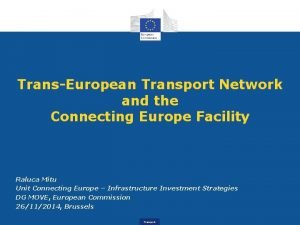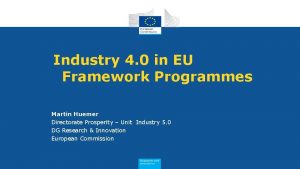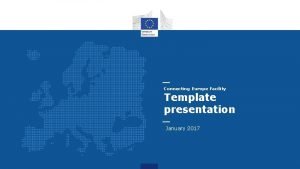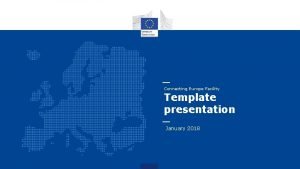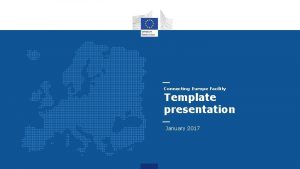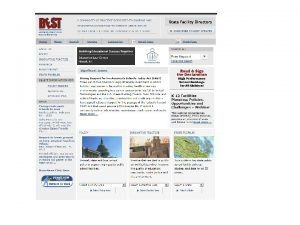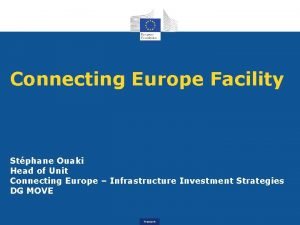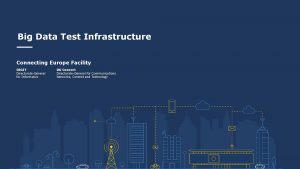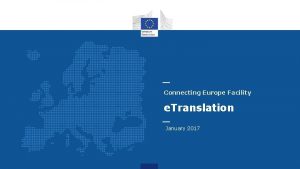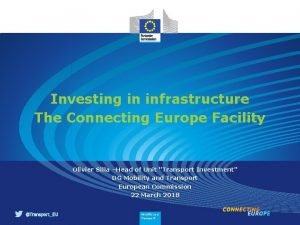Connecting Europe Facility Presentation to the Friends of

















- Slides: 17

Connecting Europe Facility Presentation to the Friends of the Presidency 4 November 2011

The Connecting Europe Facility: EU added value . . . Europe’s economic future requires smart, sustainable and fully interconnected transport, energy and digital networks => key for the Europe 2020 Strategy. Effective interconnection of networks can only be achieved at the European level, guaranteeing minimum cost to all citizens. CEF aims at supporting infrastructures with a European and Single Market dimension, targeting EU support on priority networks to be implemented by 2020 where European action is most warranted. CEF aims at building an environment conducive to private investment and develop instruments that will be attractive vehicles for specialised infrastructure investors. CEF seeks to find common solutions for all sectors, wherever possible and practical. Smart performance indicators common to CEF aligned on Europe 2020 strategy and 20 -20 -20 energy and climate change objectives, as well as specific sectoral objectives and indicators. 2 | Connecting Europe Facility

. . . Investment needs identified Transport: € 1. 5 trillion of investment needs by 2030. TEN-T alone: € 500 billion by 2020. Core Network alone requires € 250 billion by 2020. Energy: € 1 trillion of investment needs by 2020. € 200 billion of investment necessary into gas pipelines and power grids and storage facilities of EU relevance by 2020. € 100 billion at risk of not being delivered due to obstacles linked to permitting and financing difficulties. ICT: Up to € 270 billion to bring ultra-fast broadband to all households by 2020. Without stimulating effect of CEF market plans to invest no more than € 50 billion by 2020. 3 | Connecting Europe Facility

Content of the Connecting Europe Facility: implementation . . . Budget: € 50 Billion + (including € 10 Billion transferred from Cohesion Fund for transport infrastructure): € 31. 7 billion for transport (including € 10 Billion from Cohesion Fund) € 9. 2 billion for broadband digital services € 9. 1 billion for energy (2011 prices) Centralised management for grants » » » Competitive calls (or beneficiaries identified in the work programme) for the allocation of funding ‘Use it or lose it principle’ to ensure effective implementation Economies of scale and synergies between sectors to lower administrative costs Partnership with financial intermediaries (like EIB) for financial instruments Proposal on possible externalisation of tasks to come with proposal of Commission on Agencies through Executive Agency (expansion of the TEN-T EA). Implementation of projects (procurement, etc) remains responsibility of beneficiaries and MS. 4 | Connecting Europe Facility

The Connecting Europe Facility: simplification . . . . EU budget review: EU added value, simplification, flexibility, and use of financial instruments to leverage the impact of EU budget. One single regulation for financing, common to three sectors (transport, energy, ICT), replacing existing legal bases TEN-T/TEN-E and e. TEN. Maximum integration and harmonisation to ensure common rules to simplify for beneficiaries and MS: a single committee, possibility of common annual work programmes whenever synergies can be found. Specific provisions to reflect differences between sectors: multi-annual work programmes, treatment of third countries. Flexibility: midterm revision of amounts between three sectors based on performance and absorption of funds. Innovative financing instruments (multi-sector) to create a new asset class. Coordination with other EU instruments: cohesion policy instruments as well as Horizon 2020 and external instruments. Sectoral policy Guidelines to determine priorities and complementary measures of implementation, also proposed by Commission on 19 October. 5 | Connecting Europe Facility

Connecting Europe Facility: new TEN-T Guidelines . . . Problems: TEN-T today remains a patchwork of national networks: » Cross-border sections are missing, especially for rail and inland waterways, road network is very advanced. » Links between the different modes of transport are weak: ports, airports, logistic platforms need to be well connected to the various modes » National operational rules and technical systems (interoperability) block the internal transport market. Solutions: from a patchwork to a network » Realise the missing links (cross-border, bottlenecks) » Make the network intermodal: link in the nodes that allow exchange between transport modes » Make the network interoperable and efficient: ERTMS, RIS, ITS, SESAR, etc and operational rules » Use the existing infrastructure better » Make a more binding framework for realising the network Guidelines propose: (after 2 years of intense preparations with MS) » Two layer approach: core network and comprehensive network » Comprehensive network will cover entire EU, accessibility for all citizens and businesses » Core network: a selection of the most important parts of the network to be realised as a priority until 2030 6 | Connecting Europe Facility

EU 27 Core Network to be completed in 2030 7 | Connecting Europe Facility

Connecting Europe Facility: new Guidelines for Energy Aim: To provide policy and regulatory certainty to leverage the necessary investments in the priority corridors/thematic areas, necessary to meet EU’s energy and climate policy goals by 2020 and beyond: » » Efficient permit granting procedure by removing red tape and shortening administrative delays Increasing transparency and public involvement in the process » Strengthening the regulatory framework by introducing crossborder cost allocation (beneficiary pays principle) and risk related tariff incentives (user pays principle) » Financing through CEF to help prepare bankable and environmentally sound projects; to ensure access to sufficient equity and debt finance, and in exceptional cases, grants for works for projects providing external or non-commercial benefits 8 | Connecting Europe 8 Facility

Energy priorities for 2020 and beyond Priorities for 2020 Priorities beyond 2020 Electricity Highways CO 2 transport network 9 ENERGY INFRASTRUCTURE PACKAGE OCTOBER 2011 | Connecting Europe Facility

. . . Connecting Europe Facility: new ICT Guidelines Broadband deployment: » » » Portfolio of projects enabling fast and ultra-fast internet access Europe 2020 broadband objectives (access: 100% of households at 30 Mbps; use: 50% of households at 100 Mbps) Market driven » » Common digital service architectures Digital Single Market logic Grant to project consortia and procurement of European platforms Networked ICT services Move on-line and render European key services of public interest » » » Trans-European high-speed backbone connections for public administrations Cross-border delivery of e-Government services (including e-Health) Enabling access to public sector information and multilingual services Safety and security Deployment of information and communication technology solutions for intelligent energy networks and for the provision of Smart Energy Services Other services to be considered at mid term review 10 | Connecting Europe Facility

Areas for broadband deployment High correlation between the attractiveness of broadband deployment and population density and wealth 11 | Connecting Europe Facility

The Connecting Europe Facility: eligibility and project list Financial instruments: all actions contributing to projects of common interest (transport: both core and comprehensive network projects) . . . Grants: Energy (eligibility set out in Energy Guidelines): » » For all projects of common interest (except oil) for studies to help prepare bankable and environmentally sound projects For works only for projects of common interest providing external or noncommercial benefits (oil and hydro pump storage excluded) ICT: projects of common interest identified in ICT Guidelines, certain action contributing to broadband objectives Transport: only projects of common interest on core network, including deployment of new technologies & innovation, in particular works for rail and IWW » » » Traffic managements systems such as SESAR Freight transport services Reduction of rail noise Studies in PCI in third countries to link with transport networks of third countries Works for PCI in third countries covering border crossing points Annex contains list of pre-identified priorities and/or projects, delegated act foreseen to amend lists. (serves to programme up to 85% of envelope in transport) 12 | Connecting Europe Facility

Content of the Connecting Europe Facility: grants . . Co-funding rates to vary depending on sectors, with flexibility to maximise leverage and accelerate implementation Energy: » » Up to 50% for studies & works Up to 80% exceptionally e. g. for Europe-wide or regional security of supply and solidarity Transport: » » » ICT: » » » Up to 50% for studies Up to 20% for works for rail and IWW, with 30% for bottlenecks and 40% for cross-border Up to 20% for inland transport connections to ports and airports, traffic management systems, freight transport services, reduction of rail noise, Mo. S, multi-modal platforms, secure parking for core network roads Up to 50% for studies & works Up to 75% for generic services Core (European) platforms to be funded by procurement (grants allowed in exceptional cases) 13 | Connecting Europe Facility

. . . . The Connecting Europe Facility: financial instruments Financial Regulation: Commission may delegate implementation to financial intermediaries: » » » Based on lessons learned from LGTT and RSFF EIB should be the partner for Project bonds Other financial institutions are not excluded 2 types of financial instruments: » » Equity (such as Marguerite Fund) Risk-sharing instruments to provide loans and/or guarantees Estimates of the market take-up of the instruments » » € 2 bn for transport, € 1 bn for energy, (adjustment possible), higher for ICT Leverage: up to 1: 15 to 1: 20. No risk for EU budget: no guarantee entered in EU budget (same as LGTT). Residual risk with EIB. Budgetary transfer to EIB to be decided every year on basis of expected project pipeline. EIB to decide on project to be supported, (within the eligibility criteria determined by the Guidelines), on first come first serve basis, but efforts should be made to ensure sectoral and gradual geographical diversification Possibility for MS (directly or through Structural Funds), other EU funds and/or investors to top up the CEF financial instruments Details of the instruments to be set up in cooperation agreements with partners such as EIB Combination of innovative financial instruments (e. g. Project bonds) and EU direct support to optimise the impact of financing 14 | Connecting Europe Facility

The Connecting Europe Facility: the € 10 billion from Cohesion Fund (only for transport) . . . Reason: difficulties to deliver complex cross-border projects with high EU added value, especially in rail in Cohesion MS. Mechanism: transfer pro-rata of € 10 billion from Cohesion Fund Eligibility: only MS eligible to Cohesion Fund Co-funding rate: like Cohesion Fund: up to 85% (80% for phasingout, with possibility of top-up) Implementation: separate competitive calls for projects with greatest possible priority given to national allocations under Cohesion Fund Preparation: support from Commission services (specific call for proposals under TEN-T programme prior to 2014) as well as Jaspers to develop adequate project pipeline 15 | Connecting Europe Facility

The Connecting Europe Facility: External dimension . . Some Projects of Common Interest (strictly in the EU interest) on territory of third countries can be supported through grants and financial instruments in energy, transport, and ICT. In transport, support through grants is limited to three cases: » » » works to connect the core network at border crossing points; Studies to ensure the connection between the core network and the transport networks, and the connection between two core network entry points through a third country implement EU traffic management systems in third countries, especially SESAR 16 | Connecting Europe Facility

Thank you for your attention 17 | Connecting Europe Facility
 Connecting europe facility transport
Connecting europe facility transport Connecting europe facility 2021-2027
Connecting europe facility 2021-2027 Little friends may prove to be great friends
Little friends may prove to be great friends Hình ảnh bộ gõ cơ thể búng tay
Hình ảnh bộ gõ cơ thể búng tay Frameset trong html5
Frameset trong html5 Bổ thể
Bổ thể Tỉ lệ cơ thể trẻ em
Tỉ lệ cơ thể trẻ em Chó sói
Chó sói Glasgow thang điểm
Glasgow thang điểm Hát lên người ơi alleluia
Hát lên người ơi alleluia Môn thể thao bắt đầu bằng chữ f
Môn thể thao bắt đầu bằng chữ f Thế nào là hệ số cao nhất
Thế nào là hệ số cao nhất Các châu lục và đại dương trên thế giới
Các châu lục và đại dương trên thế giới Công thức tính thế năng
Công thức tính thế năng Trời xanh đây là của chúng ta thể thơ
Trời xanh đây là của chúng ta thể thơ Mật thư anh em như thể tay chân
Mật thư anh em như thể tay chân 101012 bằng
101012 bằng độ dài liên kết
độ dài liên kết
